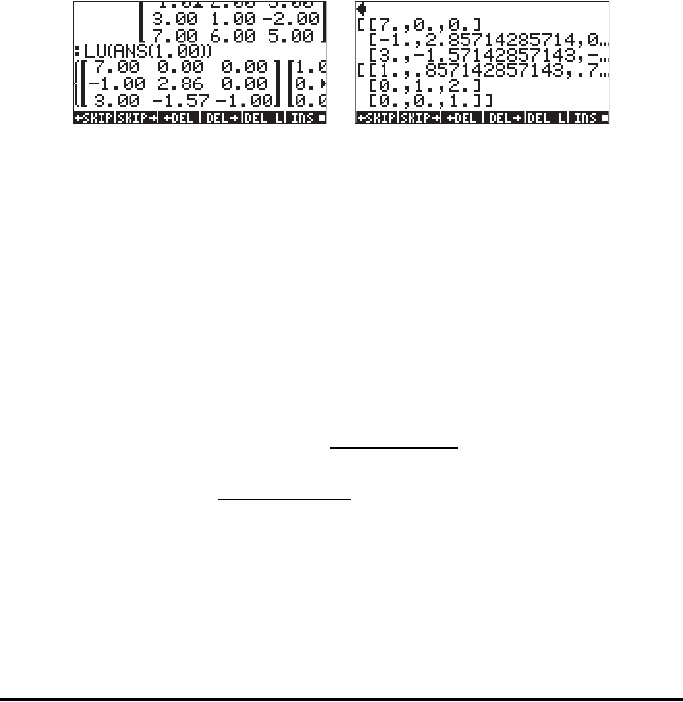
Page 11-50
Function LU
Function LU takes as input a square matrix A, and returns a lower-triangular
matrix L, an upper triangular matrix U, and a permutation matrix P, in stack
levels 3, 2, and 1, respectively. The results L, U, and P, satisfy the equation
P⋅A = L⋅U. When you call the LU function, the calculator performs a Crout LU
decomposition of A using partial pivoting.
For example, in RPN mode: [[-1,2,5][3,1,-2][7,6,5]] LU
produces:
3:[[7 0 0][-1 2.86 0][3 –1.57 –1]
2: [[1 0.86 0.71][0 1 2][0 0 1]]
1: [[0 0 1][1 0 0][0 1 0]]
In ALG mode, the same exercise will be shown as follows:
Orthogonal matrices and singular value decomposition
A square matrix is said to be orthogonal if its columns represent unit vectors that
are mutually orthogonal. Thus, if we let matrix U = [v
1
v
2
… v
n
] where the v
i
,
i = 1, 2, …, n, are column vectors, and if v
i
•
v
j
= δ
ij
, where δ
ij
is the Kronecker’s
delta function, then U will be an orthogonal matrix. This conditions also imply
that U⋅ U
T
= I.
The Singular Value Decomposition (SVD) of a rectangular matrix
A
m
×
n
consists in
determining the matrices
U
,
S
, and
V
, such that
A
m
×
n
=
U
m
×
m
⋅
S
m
×
n
⋅
V
T
n
×
n
,
where U and V are orthogonal matrices, and S is a diagonal matrix. The
diagonal elements of S are called the singular values
of A and are usually
ordered so that s
i
≥
s
i+1
, for i = 1, 2, …, n-1. The columns [u
j
] of U and [v
j
] of
V are the corresponding singular vectors
.
Function SVD
In RPN, function SVD (Singular Value Decomposition) takes as input a matrix
A
n×m
, and returns the matrices U
n×n
, V
m×m
, and a vector s in stack levels 3, 2,
and 1, respectively. The dimension of vector s is equal to the minimum of the
values n and m. The matrices U and V are as defined earlier for singular value


















